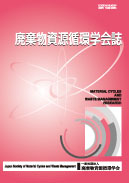Volume 21, Issue 2
Displaying 1-9 of 9 articles from this issue
- |<
- <
- 1
- >
- >|
Preface
-
2010Volume 21Issue 2 Pages 79-80
Published: 2010
Released on J-STAGE: July 29, 2014
Download PDF (207K)
Special Issues : Development of End-of-life Vehicle Recycling
-
2010Volume 21Issue 2 Pages 81-86
Published: 2010
Released on J-STAGE: July 29, 2014
Download PDF (454K) -
2010Volume 21Issue 2 Pages 87-95
Published: 2010
Released on J-STAGE: July 29, 2014
Download PDF (815K) -
2010Volume 21Issue 2 Pages 96-102
Published: 2010
Released on J-STAGE: July 29, 2014
Download PDF (623K) -
2010Volume 21Issue 2 Pages 103-110
Published: 2010
Released on J-STAGE: July 29, 2014
Download PDF (571K) -
2010Volume 21Issue 2 Pages 111-117
Published: 2010
Released on J-STAGE: July 29, 2014
Download PDF (367K)
Short Report
-
2010Volume 21Issue 2 Pages 118-121
Published: 2010
Released on J-STAGE: July 29, 2014
Download PDF (235K)
Activity Reports
-
2010Volume 21Issue 2 Pages 122-124
Published: 2010
Released on J-STAGE: July 29, 2014
Download PDF (271K)
Book Review
-
2010Volume 21Issue 2 Pages 125
Published: 2010
Released on J-STAGE: July 29, 2014
Download PDF (146K)
- |<
- <
- 1
- >
- >|
